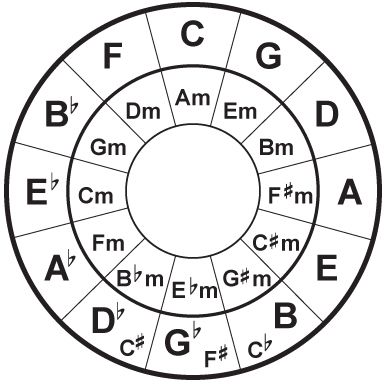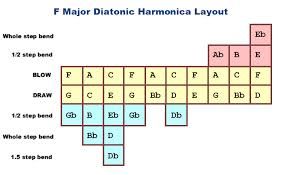Zadozica
280 posts
Dec 09, 2013
10:12 AM

|
Okay, the Circle of 5ths confuses me when it comes to minor keys.
If I want to play in Dm in either 2nd or 3rd position, what key(s) harp do I use?
|
Seven.Oh.Three.
250 posts
Dec 09, 2013
10:15 AM

|
From what I understand you'd want to play in third position to play a minor tune.... OR buy minor tuned harps.... There's a ton of info on this topic in this thread:
http://www.modernbluesharmonica.com/board/board_topic/5560960/441289.htm
|
mr_so&so
769 posts
Dec 09, 2013
10:21 AM

|
OK, you choose your position depending on whether the tune is minor or major. Some positions are more suited (easier to play the minor 3rd as an unbent note, for example) for minor, e.g. 3rd, 4th, 5th.
Select the harp to play that position in the key you want, the usual way with the circle of fifths. E.g. G for D or Dm in 2nd; C for D or Dm in 3rd. But I'd go for 3rd.
----------
 Last Edited by mr_so&so on Dec 09, 2013 10:22 AM
Last Edited by mr_so&so on Dec 09, 2013 10:22 AM
|
Adam Hamil
115 posts
Dec 09, 2013
10:26 AM

|
I think you are confusing two totally different concepts.
The circle of fifths tells you how many sharps or flats a particluar key has.
Now the positions of the harmonica are also numbered by Fifths, but that only gives you the root note of the position. Most positions can be played in major or minor, depending on the skill level of the player.
Dm can be played in a bunch of different ways. The most common ways are to play 2nd on a G harp (make sure you bend that 3d 1/2 step always) 3rd position on a C harp, or 5th on a Bb harp. Depending on what the song calls for is what would make the determination for me. If I wanted to play lower melodic notes and limited chords, I would go for 2nd (G Harp) If it was chords I was looking for and wanted lighting fast Melody over two octaves< I would play 3rd (C Harp) If I were switching B/t Dm and It's relative Major (F) I would use 5th (Bb Harp)
That's my 2 cents, I hope it helps
----------
C. Adam Hamil
HOHNER CERTIFIED Free Reed Instrument Technician
Last Edited by Adam Hamil on Dec 09, 2013 10:28 AM
|
Zadozica
281 posts
Dec 09, 2013
10:40 AM

|
"I think you are confusing two totally different concepts"
I can relate to that. I am actually trying to play or figure out, how to play Vanilla Queen by Golden Earring and it is in Dm.
It makes perfect sense to me that 2nd on a G is D. But how does that translate to minor? Maybe 3rd is better since that is more minor sounding?
|
The Iceman
1315 posts
Dec 09, 2013
10:46 AM

|
"It makes perfect sense to me that 2nd on a G is D. But how does that translate to minor?"
Here is where knowledge of where the notes live in the harmonica coupled with understanding technique to create notes not "given" to you.
In this case, you play in 2nd position, but when inhaling hole #3, you must place it 1/2 step below the given note using bending technique...i.e., creating the minor third in this hole.
----------
The Iceman
|
STME58
601 posts
Dec 09, 2013
10:51 AM

|
Every major scale has a relative minor. That is a scale with all the same notes but a different home position. Many circle of fifths have the relative minors printed on them.
A good way to understand this is on a keyboard. C major is all the white keys starting on C. If you play this you will hear the familiar C major scale. The relative minor of C is Am. Am shares all of its notes with C major. If you start on A on the keyboard and go up the white keys to A you will play an A minor scale.
Now, take you C harp and start on 6 draw (A) and go up the scale, that's A minor. Make 6 draw (and 10 draw and 3 draw whole step bend) home on any harp and you are in minor. I believe this would be called 4th position as you are playing Am on a C harp, and A is the 4th stop around the circle from C. To me it is somewhat analogous to playing in major in first position because you can get all of the notes in the scale without bending.
As Adam points out, it is not the only way to get minor, but I find it a good place to start.
You can also reverse this process to find the major scale on a minor tuned harp.
Last Edited by STME58 on Dec 09, 2013 10:52 AM
|
Zadozica
282 posts
Dec 09, 2013
10:52 AM

|
"In this case, you play in 2nd position, but when inhaling hole #3, you must place it 1/2 step below the given note using bending technique...i.e., creating the minor third in this hole."
So playing the Blues Scale is automatically minor and playing the blues scale in second on a C harp is Gm?
An F harp would have D as the 6 draw - dang, don't have that key..
Last Edited by Zadozica on Dec 09, 2013 11:01 AM
|
STME58
602 posts
Dec 09, 2013
11:12 AM

|
"Here is where knowledge of where the notes live in the harmonica coupled with understanding technique to create notes not "given" to you."
This is a real gem by Iceman.
The notes in D minor are D,E,F,G,A,Bb,C.
Find these on any harp and you can play D minor. As you noted, these notes are all on an F harp. All of these but Bb are on a C harp. Find a way to play Bb and avoid B ( 6 and 10 overblow, 3 draw 1/2 step bend are Bb on a C harp) and you can play D minor on a C harp (3rd position)
Last Edited by STME58 on Dec 09, 2013 11:13 AM
|
gene
1139 posts
Dec 09, 2013
11:33 AM

|
Simple answer:
Look at a Co5 and find the D, ignoring the word "minor". 2nd position is played on the G harp, and 3rd position is played on the C harp.
Last Edited by gene on Dec 09, 2013 11:34 AM
|
The Iceman
1316 posts
Dec 09, 2013
1:04 PM

|
"So playing the Blues Scale is automatically minor and playing the blues scale in second on a C harp is Gm?"
yeah, kinda sorta.
Here is where the theory can get confusing till you absorb the knowledge.
The notes used in the blues scale can be thought of as good Gm note choices and will work, but if all you use are these notes, what you play will sound more like blues ideas than ideas adaptable to all types of music.
The beauty of the blues scale is that these note choices also sound pretty cool over G7 as well. When you dive into the theory behind it, you will learn why these notes can work with both Gm and G7...however, you don't need this theory knowledge to play, but it certainly will help you in the long run be a better musician.
----------
The Iceman
|
tmf714
2234 posts
Dec 09, 2013
1:22 PM

|
I'll post this in the "Relative Minor" thread as well-

|
Zadozica
283 posts
Dec 09, 2013
1:45 PM

|
So the question I have left is........
How do you know the scale for the corresponding key? For example, Dm on an F harp - how do you know the scale......
Wait a minute - the dude in Austin had this as part of his meat and potatoes series. Time to get me some educating....
Thanks all.
|
tmf714
2236 posts
Dec 09, 2013
1:51 PM

|
D minor scale-< D, E, F, G, A, Bb,C
The relative major is-< F, G, A, Bb, C, D, E
Find the corresponding D minor notes on the F harp-Voila!
This chart may help-http://www.leeoskar.com/documentation/MajorDiatonic-Notation-Chart.pdf
Or this-
 Last Edited by tmf714 on Dec 09, 2013 1:58 PM
Last Edited by tmf714 on Dec 09, 2013 1:58 PM
|
Zadozica
284 posts
Dec 09, 2013
2:20 PM

|
Thank you very much. That helps a lot.
|
STME58
603 posts
Dec 09, 2013
2:28 PM

|
Seeing that the circle is posted above, I will share a couple of things about it I have found helpful.
C is at the top and has no sharps or flats. As you go clockwise around the circle you add a sharp each time (or take away a flat). As you go counterclockwise you add a flat each time (or take away a sharp. Thus the key of G major has one sharp and the key of F major has one flat. This rule holds true for both the minor and major rings of the wheel. A minor has no sharps or flats, D minor has one flat and E minor has one sharp.
Sharps are added in the order that appears in the circle starting with F. Thus the key of A has 3 sharps(clockwise rule) and the are F,C and G. I learned to remember the order with the acrostic, Fat Cats Go Down An Elevator Backwards.
Flats are added in the order counterclockwise around the circle starting with Bb. Thus the key of Eb has 3 flats (counterclockwise rule) and they are B, E, and A. The memory device I learned for this is that the the first 4 flats in order spells the word BEAD.
The next key clockwise after C# is G# and will have a F double sharp in the key signature but we usually just call it Ab and write it with 4 flats. I have never come across it. You can continue around the wheel adding double sharps but there is not much point in it other than perhaps to deepen your understandings of the patterns in the circle. Most circle of fifths show only the bottom 3 enharmonics, C#/Db, F#/Gb, and B/Cb. Thats as far as you can go without double flats or sharps.
The next key in the pattern counterclockwise after Cb is Fb. It has a B double flat and is usually just called E and is written with 4 sharps. It can be fun to call a tune in Fb and watch the uninitiated panic. I know Kim Wilson does a tune in Fb.
There are a lot of interesting patterns in this but these are a few I have found most helpful/interesting.
Last Edited by STME58 on Dec 09, 2013 2:31 PM
|
Ugly Bones Ryan
13 posts
Dec 09, 2013
4:14 PM

|
In third position you'd need a C harp and second you'd need a G harp.
|